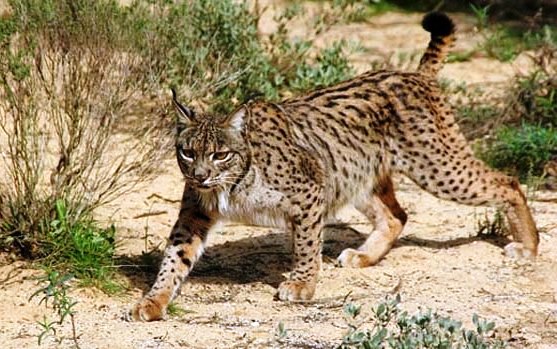The Iberian lynx (Lynx pardinus; also known as the Spanish lynx), which inhabits the shrublands of southwestern Spain and Portugal, was on the verge of extinction at the beginning of the twenty-first century. At that time, this wild cat species was estimated to number fewer than 100 individuals, designating it as the world's most endangered feline. However, the Iberian lynx population has bounced back to approximately 550 individuals as the result of dedicated conservation and reintroduction efforts, enabling this rarest of cat species to be removed from the critically endangered list by the International Union for Conservation of Nature and Natural Resources (IUCN). However, the animal remains classified as an endangered species, and conservation measures must continue to be implemented and strictly followed to ensure its future viability. See also: Biodiversity; Cat; Conservation (species); Ecology; Endangered species; Extinction; Population ecology; Population viability

Through a conglomeration of both governmental and privately funded organizations, the Iberian lynx has been the target of conservation endeavors that have aimed to reintroduce lynxes into their native habitats in the Iberian Peninsula and to maintain the cat's primary food source—rabbits. Efforts began in the early 2000s, when conservationists secured legislative protection for numerous habitats of the lynxes and helped to outlaw the hunting of these wild cats. Then, beginning in 2014, about 50 lynxes per year have been bred in captivity and reintroduced back into the wild. So far, these reintroduction efforts have been remarkably successful. With regard to preservation of the lynx's prey, conservation measures have focused on the restocking of rabbits and the elimination of diseases (in particular, infectious myxomatosis and rabbit hemorrhagic disease) that adversely affected rabbit populations over the past few decades. By maintaining the abundance of rabbit populations, the Iberian lynx has seen its population numbers increase in a similar fashion. In addition, other conservation efforts are being put into action, such as preventing the loss and fragmentation of the lynx's habitat as a result of the addition of infrastructure and roads, raising awareness of the public in order to decrease lynx fatalities due to road and traffic accidents, and creating wildlife corridors (whereby the animals could bypass various barriers due to infrastructure, thereby expanding their range for survival). See also: Animal virus; Connected wildlands: corridors for survival; Environment; Environmental management; Infectious myxomatosis; Lagomorpha; Land-use planning; Predator-prey interactions





